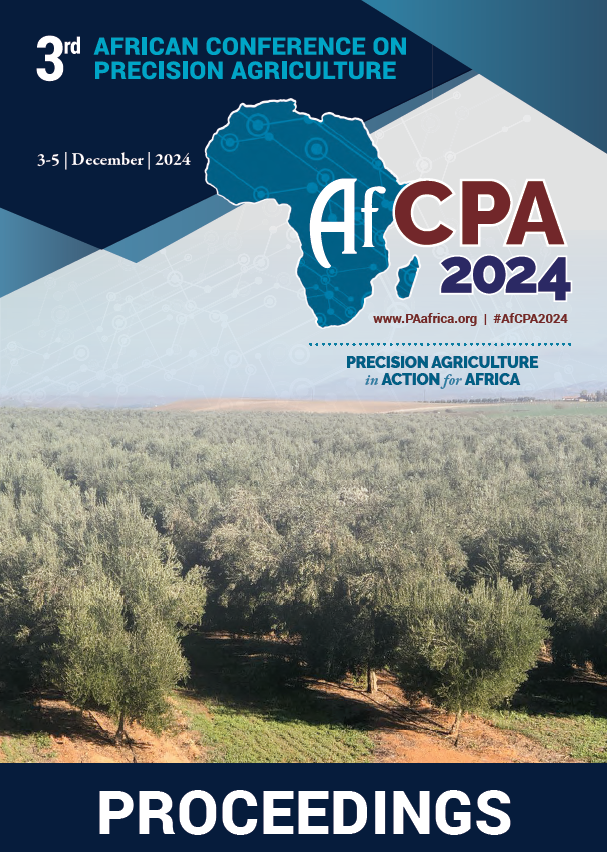Download the Conference Proceedings
Proceedings
Authors
| Filter results9 paper(s) found. |
|---|
1. Excellence in Agronomy 2030: A new CGIAR-wide initiative to deliver agronomy solutions at scaleRequired increases in crop production and productivity in sub-Saharan Africa (SSA) will not happen without the increased use of appropriate agronomic practices. While several thousand new varieties of nearly all key crops have been produced in the past decade, recent increases in yields in specific countries have only happened when such varieties received the right agro-inputs and management. That said, agronomy is often highlighted as an area that has not delivered impact at scale in SSA, or... B. Vanlauwe, T. Amede, F. Baudron, P. Chivenge, M. Devare, K. Saito, J. Kihara, V. Nangia, P. Pypers, K. Shepherd, E. Vandamme |
2. Preparation of a precision ripping plan using manual vertical penetrometer measurementsLarge weight power engines and tools used in agriculture significantly contribute to the formation of compacted and thickening layers starting from the soil surface. There are suitable deep ripping technologies to eliminate harmful soil compaction, which are extremely energy and cost demanding. In precision agriculture, it is possible to treat spatially delimited unfavourable soil patches. The bulk density (g/cm3) of the soil was calculated from the soil resistance and moisture content... T. Rátonyi, P. Ragán, A. Széles, P. Fejér, E. Harsányi, I. Bácskai |
3. A cheap alternative to data management and creating of yield maps of small-plot field experimentsLong-term field trials provide an opportunity to examine the long-term effects of crop production factors and the effect of different crop years can also be analysed. In the long-term field trial, spatial representation of the data belonging to each plot might be necessary for the purpose of soil heterogeneity analysis, working hypothesis, or even presentation. Researchers dealing with long-term field trials usually store the measurement data for a given experiment in Excel or in a database of... P. Ragán, T. Rátonyi, A. Széles, P. Fejér, I. Bácskai, E. Harsányi |
4. Soil mapping with the VERIS U3 soil scanner in a precision farm in HungaryCurrently, field crop production faces constant challenges. Extreme climatic conditions, deteriorating circumstances on the field have a negative impact on the quantity and quality of available yields, and the ever-changing agro-economic environment makes the profitability of the sector uncertain. Precision crop production means site-specific agricultural cultivation tied to geographical coordinates. Modern strip tillage technology based on precision technology for crops with wide row spacing... P. Ragán, E. Harsányi, T. Rátonyi, A. Széles, P. Fejér, I. Bácskai |
5. REVISITING INLAND VALLEYS MANAGEMENT STANDARDS IN THE CONTEXT OF GLOBAL CHANGE IN WEST AFRICAConsidered as main alternative to the crisis of traditional production systems, inland valleys management pains more and more to fill expectations of West African’s farmers due to the inadequacy, in the current context of climate, agrarian and environmental change of the management standards applied to these ecosystems. One consequence of this inadequacy is the inefficient exploitation of the inland valleys with the results being the persistence of the food insecurity, environmental degradation... A. Tidjani, P. Tovihoudji |
6. Determining Nutrients rates for Maize, Rice, Cotton, and Tomato in Dry Savannah zone of Togo based on site specific nutrient management approachInadequate fertilizer application limits crop yields and lead to the soil fertility depletion. This study aims at formulating nutrients rates recommendations for main the crops in dry savannah zone of Togo. Site specific nutrient management approach based on spatial variations in nutrients status, crops nutrients requirement and average crop yields under field conditions was used to determine recommendations rates in N, P and K. For maize cropping, nutrients needs are 94 kgN.ha-1, 42... |
7. Mapping African soils at 30m resolution - iSDAsoil - Western Time Zones“iSDAsoil” combines remote sensing data and other geospatial information with carefully stratified point samples subjected to spectral analysis and traditional wet chemistry reference analysis. State of the art machine learning techniques were used to create digital maps of 17 agronomically important soil properties at 3 depths, including estimates of uncertainty. iSDAsoil is designed to encourage sharing and we hope that the owners of other soil and agronomic data, in industry... J. Crouch, K. Shephard, M. Miller, J. Collinson, P. Singh, P. Pypers, R. Van den bosch, C. Van beek, M. Chernet, S. Aston |
8. Engaging Stakeholders in Precision Agriculture Toolbox Conception: Case of Cowpea Atlas Platform Establishment in Benin RepublicCowpea [(Vigna Unguiculata (L.) Walpers] is among the most preferred and consumed legumes in West Africa and grown by many smallholder farmers. The crop has huge potential, is easy to grow and constitute a source of income of many actors involved in different value chains. Unfortunately, despite many interventions which aimed at promoting the crop in West Africa mainly Benin, areas under cowpea crop decrease over the years along with the loss of cowpea-based products. Such problem is... N.V. Fassinou hotegni, Y.L. Godonou, L.M. Gnanglè, O.N. Coulibaly, E.G. Achigan-dako |
9. Precision Maize Nutrition: Evidences from On-farm Experimentation of Quefts Estimated Nutrient Requirement for Variable Densities in Smallholder Farmers in EthiopiaQuantitative Evaluation of the Fertility of Tropical Soils (QUEFTS) model is an important tool for estimating optimal nutrient requirement of crops. The study was conducted to evaluate QUEFTS estimated (QE) nutrient requirement of maize in two pant densities (32,443 and 53,333 plants/ha in Central Rift Valley (CRV); 27724 and 62,000 plants/ha in Jimma) on fields of three farmers wealth classes (poor, medium and wealth) in contrasting agro-ecologies of Ethiopia. QUEFTS follows a target oriented... W.B. Kenea, T.B. Tura, A.N. Woldekristos |
